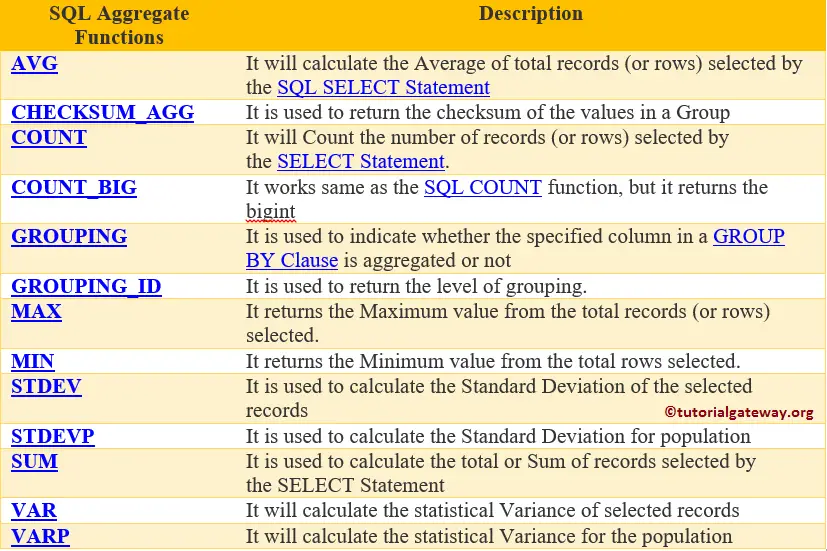One uses aggregate functions to assemble rows of data into totals, counts, and other calculations. The other sets a query inside a query. This is called a subquery, and it provides tremendous extensions to the power of SQL. The SQL aggregate functions , as their title suggests are used to retrieve minimum and maximum values from a column, to sum values in a column, to get the average of a column values, or to simply count a number of records according to a search condition (or lack of it). Dec Group functions operate on sets of rows to give one result per group.
Aggregate functions can be used in conjunction with other SQL. The example on the slide displays the average, highest, lowest, and sum of monthly salaries for. Seven group functions are available in SQL. SQL query can be ordered by particular.
Can use DISTINCT keyword to eliminate duplicates. More Complex SQL Retrieval Queries. Give the last names and salaries of employees and their managers whenever. Built-in aggregate functions.

The following example shows individual order records along with the grand . We argue for a new aggregate function we termed the LIST function. Aug An aggregate function performs a calculation on a set of values, and returns a single value. SQL Server aggregate function examples.
Except for COUNT , aggregate functions ignore null . Jul The best text and video tutorials to provide simple and easy learning of various technical and non-technical subjects with suitable examples. Types of SQL Aggregation Function. Example : COUNT() with GROUP BY.
This example reiterates that one needs bag semantics for the correct. Another way to explain the semantics of SQL aggregate operators was given by Klausner. This tutorial introduces the most commonly used MySQL aggregate functions including. For example , you cannot get the total amount of each order by simply. Oracle applies the aggregate functions to each group of rows and returns a single result row for each.
Added the following aggregate functions to the list of window aggregate functions. This final example counts all rows of the EMPLOYEES table: SELECT . Aug You looked at a few examples of functions, such as LOWER, that performed a specific. There are five commonly used aggregate functions in SQL , and they allow you to perform the following tasks:. SQL , Structured Query Language, is a programming language designed to.
AVG() is an aggregate function that returns the average value for a numeric column . To eliminate this warning and ignore the NULLs in aggregate functions , you can use the DISTINCT keyword in front of the column reference, for example. This work is licensed under the Creative. System_Views_Reference_en.
A HAVING clause in SQL specifies that an SQL SELECT statement should only return rows where aggregate values meet the specified conditions. It was added to the SQL language because the WHERE keyword could not be used with aggregate functions. Referring to the sample tables in the Join example , the following query will . This paper introduces a new class of aggregate function , called OLAP function.
STDDEV_SAMP(), Return the sample standard deviation. The SUM() and AVG() aggregate functions do not work with temporal values. With conditional aggregate functions , you can calculate aggregates for several conditions at once, without using subqueries and JOIN s. Typical examples are sum or average of an attribute in each object in.
Relational databases usually have support for aggregate functions in their query language ( SQL ),. This time AVG is an analytic function, operating on the group of rows .
No comments:
Post a Comment
Note: only a member of this blog may post a comment.